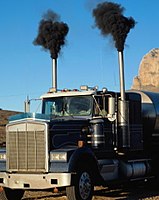
Photo from wikipedia
Abstract The aim of the research was to determine selected fuel properties and basic emission characteristics of briquettes made from cones of three tree species: Scots pine (Pinus sylvestris L.),… Click to show full abstract
Abstract The aim of the research was to determine selected fuel properties and basic emission characteristics of briquettes made from cones of three tree species: Scots pine (Pinus sylvestris L.), Norway spruce (Picea abies H. Karst.) and European larch (Larix decidua Mill.). Combustion tests were carried out under stabilized operating conditions (heat output, excess air coefficient) on a grate-fired combustion device. The elemental composition of the cone samples and the heating values were determined. The briquettes were evaluated in terms of carbon monoxide and nitrogen oxide emission concentrations depending on the excess air factor and the flue gas temperature. The composition and energy content of the cone materials were comparable to wood. In the dry state, the ash content was between 0.69 and 1.29% wt. and the lower heating values between 18.77 and 19.58 MJ·kg−1. This suggests favourable properties for use as a solid biofuel. However, during combustion all cone briquettes achieved higher emission levels of nitrogen oxides as well as carbon monoxide compared to spruce wood briquettes. Larch cone briquettes were consistently the highest in emissions which reached concentrations of carbon monoxide in flue gas up to 3500 mg·m−3. On the other hand, spruce and pine cone briquettes kept concentrations of carbon monoxide below 2000 mg·m−3 at excess air coefficients under 2.4. The amount of excess air significantly influenced the temperature of the exhaust gas, which was maintained above 300 °C during the tests. In the tested areas and the excess air coefficients the concentrations of nitrogen oxides did not exceed 200 mg·m−3 and were low for all samples.
Journal Title: Fuel
Year Published: 2020
Link to full text (if available)
Share on Social Media: Sign Up to like & get
recommendations!